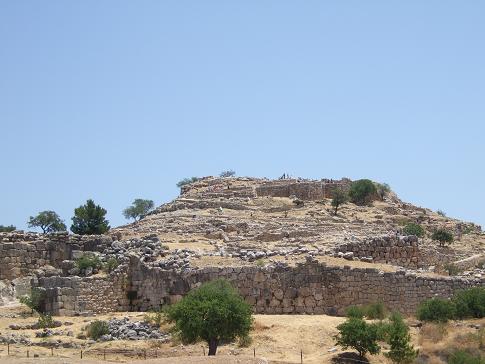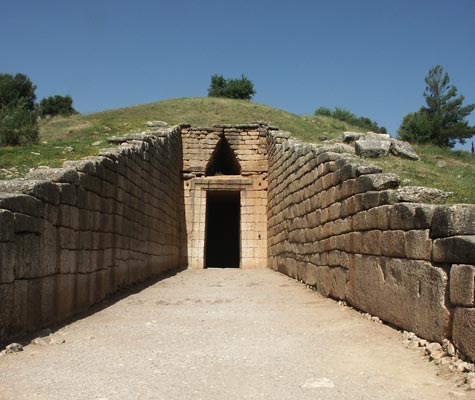 The ruins of an ancient city state of Mycenae enae, located in the North-East part of Peloponnese in Argolis, (about 1.5 hours away from Athens), dates back to the second millennium B.C. Situated on top of a rocky hill high above the modern town, it is an imposing site. In its days of power it equalled its other city state contemporaries such as Athens, Corinth, and Sparta in its pursuit of art, wealth and military might. The riches and artefacts uncovered in the various sites are now on display in the National Archaeological Museum of Athens and Mycenae. At one point the Mycenaean’s controlled the island of Crete. The term "Mycenaean," applies to an entire culture spanning the years 1700-1100 BC.
The ruins of an ancient city state of Mycenae enae, located in the North-East part of Peloponnese in Argolis, (about 1.5 hours away from Athens), dates back to the second millennium B.C. Situated on top of a rocky hill high above the modern town, it is an imposing site. In its days of power it equalled its other city state contemporaries such as Athens, Corinth, and Sparta in its pursuit of art, wealth and military might. The riches and artefacts uncovered in the various sites are now on display in the National Archaeological Museum of Athens and Mycenae. At one point the Mycenaean’s controlled the island of Crete. The term "Mycenaean," applies to an entire culture spanning the years 1700-1100 BC.Legend & Myth
Legend has it that Mycenae was founded by Perseus and its most famous king immortalized in Greek epics is Agamemnon. As per versions drawn from epics and legends Agamemnon were married to Clytemnestra and his brother Menelaus, who was also the king of Sparta was married to the beautiful Helen. Aphrodite the Goddess of Beauty and Love offered Helen to a Trojan prince, Paris and Helen some what willingly went with Paris to Troy. This enraged the brothers and Agamemnon built a war contingent of some of the best warriors, and set sail to Troy to bring back Helen. This resulted in the Trojan War which lasted for ten years and is best described in The Iliad by Homer. During these ten years, Clytemnestra finds a lover, Aigisthos. They drive Agamemnon's son Orestes and his daughter, Electra, into exile and rule Mycenae together. Upon Agamemnon's return, they murder him in his bath with an axe. After ten more years Orestes finds him self at the Temple of Apollo at Delphi. Apollo asks Orestes to avenge his father’s death by slaying his mother and her lover. So he returns to Mycenae and kills both, Clytemnestra and Aigisthos. This act rises up The Furies from the Earth and they try to take vengeance for killing ones mother was a serious crime. The Furies chase Orestes to Delphi where Apollo tells Orestes to go to Athens and ask for Athena, The Patron Goddesses forgiveness. He goes to Athens where he seeks shelter in the temple of Athena and begs for forgiveness. He is put on trial by the Athenians in front of the Areopagus. The jury results in a tie and Athena casts the final vote which declares him not guilty. This was the first instance of a jury trial. Athena then asks the Furies to spare the city from their wrath and the furies agree. (The Libation Barriers, Eumnides). This is just a compilation of the myths and legends that surround Mycenae.
These events may have happened and later were immortalized by poets in their epics. The city exists and a large number of people visit it every year, drawn by the power of legends and history.
The most interesting ruins that still remain are:
Acropolis: All that remains today of the acropolis are the building foundations, and the immense wall that crowns the top of the hill. It sits atop an impressive mountain and is flanked on either side by taller mountains forming a very formidable fortification for the site. Only the ruling class inhabited the hilltop palace, with artisans and merchants living just outside the city walls. It was abandoned in 1100 BC after a period of great disruption in the region
 Lion Gates: It is the earliest known piece of monumental sculpture in the European continent. Through this you enter the Acropolis.
Lion Gates: It is the earliest known piece of monumental sculpture in the European continent. Through this you enter the Acropolis.
The Palace: The Palace was built on the summit and along massive terraces on the south-western and eastern slopes of the hill. The official entrance was via an H-shaped Propylon. The current main approach to the palace is through the Great Ramp which begins at the back end, just beyond the Lion Gate.
 Lion Gates: It is the earliest known piece of monumental sculpture in the European continent. Through this you enter the Acropolis.
Lion Gates: It is the earliest known piece of monumental sculpture in the European continent. Through this you enter the Acropolis.The Palace: The Palace was built on the summit and along massive terraces on the south-western and eastern slopes of the hill. The official entrance was via an H-shaped Propylon. The current main approach to the palace is through the Great Ramp which begins at the back end, just beyond the Lion Gate.
Grave Circle A: Circle A is very similar in layout to Circle B but was used slightly later. It is located just inside the Lion Gate, but only after the extension of the ramparts in the 13th century BC, before that it was outside the walls. Useful links: http://www.odysseyadventures.ca/articles/mycenae/mycenae_circle-a_plan; http://www.odysseyadventures.ca/articles/mycenae/mycenae_circle-a_objects; http://www.odysseyadventures.ca/articles/mycenae/mycenae_circle-a_jewellery.htm
Grave Circle B: beyond the fortification walls were the graves of the earliest kings of Mycenae and their families, enclosed by a low circular wall. The circle partly underlay a later Tholos Tomb, known as the Tomb of Clytemnestra, and was discovered in the course of restoration work to it in 1951. Useful links: http://www.odysseyadventures.ca/mycenae_circle-b_plan
Grave Circle B: beyond the fortification walls were the graves of the earliest kings of Mycenae and their families, enclosed by a low circular wall. The circle partly underlay a later Tholos Tomb, known as the Tomb of Clytemnestra, and was discovered in the course of restoration work to it in 1951. Useful links: http://www.odysseyadventures.ca/mycenae_circle-b_plan
 Treasury
Treasury  of Atreus: It is a beautiful Tholos Tomb built around 1250 BC, also known as ‘Tomb of Agamemnon’. The size of the tomb and the masonry work is awe inspiring. Despite its name, no treasures were found in the tomb as it was pillaged in ancient times. It is situated on another hill opposite the palace just beyond the general parking lot and is easily accessible from the road. You can enter by showing the ticket you bought at Mycenae. Useful links: http://www.odysseyadventures.ca/articles/mycenae/mycenae_atreus-plan.htm
of Atreus: It is a beautiful Tholos Tomb built around 1250 BC, also known as ‘Tomb of Agamemnon’. The size of the tomb and the masonry work is awe inspiring. Despite its name, no treasures were found in the tomb as it was pillaged in ancient times. It is situated on another hill opposite the palace just beyond the general parking lot and is easily accessible from the road. You can enter by showing the ticket you bought at Mycenae. Useful links: http://www.odysseyadventures.ca/articles/mycenae/mycenae_atreus-plan.htmThough many of the artefacts that were unearthed at Mycenae have been taken and are currently exhibited at the National Archaeological Museum, Athens, the National Archaeological Museum of Mycenae is also full of important artefacts and definitely worth a visit.
Important Information
Mycenae is a challenging site to navigate. There is a steep climb through the ruins with rocky paths and practically no respite from the burning sun. Hence dress lightly, wear steady, comfortable shoes, carry a sun hat, eyeshades, sun-screen lotion and bottled water.
The excursion may vary between 1 – 2 hrs depending on your pace. Remember once you pass the ticket booth there is no place to buy water or toilet facilities. Hence first go near the museum before entering the Lion Gates. However, it would be best to climb the ancient ruins first and save the museum visit for the hotter part of the day.
Enter the site through the Lion Gate and follow the well marked path up the hill, past the palace, all the way to the Northern Gate. If you wish to descent down to the underground cistern carry a flash light since the tunnel is completely dark, steep, and slippery.
By 10:00 AM quite a number of tourist buses arrive resulting in full parking lots, long lines at the ticket counter, and a site that is difficult to navigate. Hence it’s best to reach early and finish the ruins before the arrival of the tourist buses and the sun becomes scorching. But if you are coming by one of the tour buses choose one that reaches the earliest.
How to Reach
From Athens by Car: Driving from athens you take the national road that goes south through Corinth and towards Tripoli. Take the Sterna exit and go east through Argos to Mycenae. The trip will take you about 2 hours.
From Athens airport Mycenae is roughly a 2.5 hours drive
From Pireas Port the drive along the bewitching coastline takes about 2-2.5 hours. http://books.google.com/books?id=5hdsVl8cBgwC&pg=PA508&lpg=PA508&dq=How+to+Reach+Mycenae&source=bl&ots=xoaVrjF6JA&sig=9k7dz1B5JZmXmizb0WYR8GZwQAc&hl=en&ei=_rLQScbgKaCUjAfz0ojfBA&sa=X&oi=book_result&resnum=7&ct=result
From Athens by Bus: There are several buses that leave daily for Mycenae from Athens. More information can be obtained at http://www.ktel.org/. Moreover, many buses ply from Athens to Mycenae from the KTEL long distance bus terminals.
It is also on the tour bus circuit hence a lot of options are available from Athens and Nauplion
From Athens by Bus: There are several buses that leave daily for Mycenae from Athens. More information can be obtained at http://www.ktel.org/. Moreover, many buses ply from Athens to Mycenae from the KTEL long distance bus terminals.
It is also on the tour bus circuit hence a lot of options are available from Athens and Nauplion




No comments:
Post a Comment